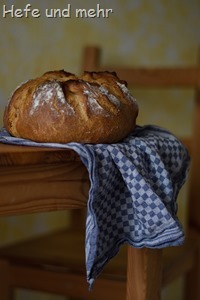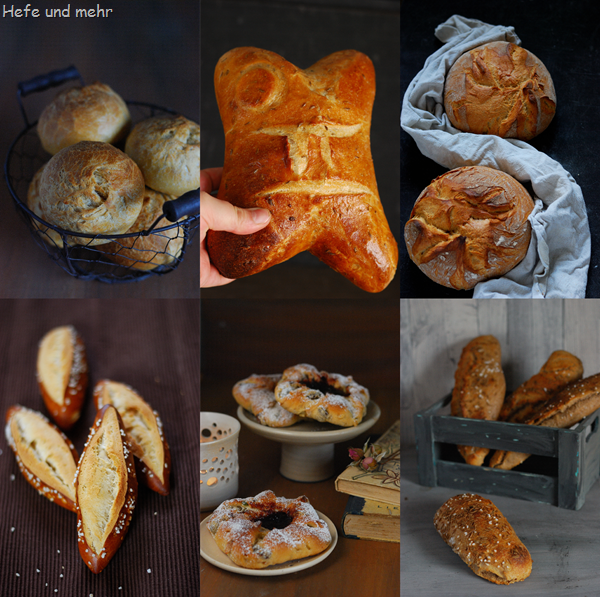
Kouign Amann
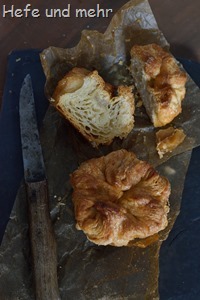 Butter is a staple in the Breton kitchen – which shows in the Sablé Breton. Another example for buttery Breton cake is Kouign Amann. It is made of a very rich croissant dough and the dough is then turned in sugar before forming. During the long baking time the sugar caramelize on the bottom of the cake to crackling layer, forms a sweet soft core in the middle of the cake and again caramelizes on the top.
Butter is a staple in the Breton kitchen – which shows in the Sablé Breton. Another example for buttery Breton cake is Kouign Amann. It is made of a very rich croissant dough and the dough is then turned in sugar before forming. During the long baking time the sugar caramelize on the bottom of the cake to crackling layer, forms a sweet soft core in the middle of the cake and again caramelizes on the top.
My variant of this high caloric treat is a spin off of my actual sourdough croissant project. And while the croissant needs still a bit of tweaking, I’m more then happy with the Kouign Amann in this sweet starter variant. It is not a recipe for inpatient people, just the proof of the dough takes place over night at room temperature. But investing about 24 hours in this cake is more then worth, as this long proof creats a fantastic complex flavour with only a faint hint of sour. If you like palmiers, you will love the buttery caramelic Kouign Amann as well!
Double baked Farmers Bread
One of the best methods to achieve a thick, crunchy crust is to bake a bread twice: after cooling down the bread is placed in the oven for a second time for about 15 min. During that time the crust gets its extra bit of crispiness.
And this method I used for this farmers bread. It contains 15% Rye flour and the typical Bavarian bread spice mixture of caraway, fennel and coriander seeds. If you, like me, have a well stocked supply of spices then it is easy to mix the needed spices by yourself. For grinding you can use either a mortar and pestle, a food processor or a coffee mill. And if you have a grain mill which allows you to mill oily seeds, then the easiest way is to mill the seeds with some wheat berries – just remember to reduce the amount of flour accordingly to the amount of wheat you mill.
The amount of bread spice is seasoning in a discreet way without overpowering the other flavours of the bread. This makes this bread suitable for hearty cheese as well for sweet spreads like honey.
Kekkis Everyday Bread
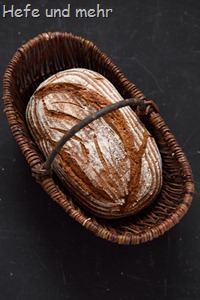 I like recipe tweaking – especially when this happens so spontaneously like here. Duríng a nice exchange about sweet starter the questions occurred how to add the starter in a existing and trusted everyday bread recipe. I offered help and Kekki posted her formula and the wishes for the new versions. The recipe sounded very good, made with Kefir or Buttermilk, 20% rye and 80% wheat. I exchanged the wheat sourdough with sweet starter and added a long, cold autolysis for the whole grain flour. And I baked the recipe directly, as it sounded so tempting. And I was not disappointed: The bread is very flavourful, with a hearty tangy note, good crust and soft crump. A true everyday bread!
I like recipe tweaking – especially when this happens so spontaneously like here. Duríng a nice exchange about sweet starter the questions occurred how to add the starter in a existing and trusted everyday bread recipe. I offered help and Kekki posted her formula and the wishes for the new versions. The recipe sounded very good, made with Kefir or Buttermilk, 20% rye and 80% wheat. I exchanged the wheat sourdough with sweet starter and added a long, cold autolysis for the whole grain flour. And I baked the recipe directly, as it sounded so tempting. And I was not disappointed: The bread is very flavourful, with a hearty tangy note, good crust and soft crump. A true everyday bread!
Kifle
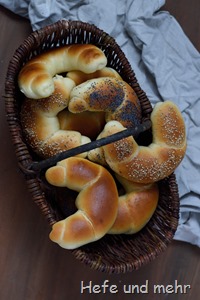 Some Weeks ago a reader send me a recipe asking if I could change it to less yeast and with the possibility to let the rolls proof overnight in the fridge. The recipe was – to use the famous words of Alfred Biolek – “interesting” as it contained not only a lot of yeast but baking powder as well. So it was not very surprisingly that the recipe yielded roll which taste not so good and get stale very fast.
Some Weeks ago a reader send me a recipe asking if I could change it to less yeast and with the possibility to let the rolls proof overnight in the fridge. The recipe was – to use the famous words of Alfred Biolek – “interesting” as it contained not only a lot of yeast but baking powder as well. So it was not very surprisingly that the recipe yielded roll which taste not so good and get stale very fast.
And my recipe variant only contains now hints of the old one. With a poolish, a water roux, adjusted yeast amount and no baking powder it is a complete different story. I had to adjust the amounts of flour as well as my first draft was getting slightly on the to wet side. The final formula has still a higher hydration then the original recipe, but the dough is good to handle when the gluten network is fully developed.
And I am more then pleased with the Kifle. They have very fluffy crumb and a perfect soft crust and develop a fine flavour due to poolish and yoghurt. A perfect roll for both sweet and hearty Spreads.
Witbrood
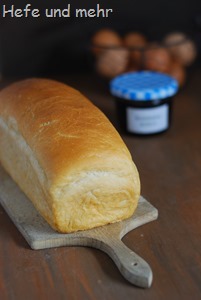 Björn posted a series of fluffy Netherland breads back in January. One of these Breads was the classical Witbrood. It looked temping soft and fluffy. I bake those breads rather seldom, but when we finally felt a longing for a fluffy bread, I decided to use Björns Bread as Inspiration. My Witbrood-Variant is made with a mild sourdough and 2% yeast. This is for me a rather high amount, but it helps to create a high risen bread in a considerably short time.
Björn posted a series of fluffy Netherland breads back in January. One of these Breads was the classical Witbrood. It looked temping soft and fluffy. I bake those breads rather seldom, but when we finally felt a longing for a fluffy bread, I decided to use Björns Bread as Inspiration. My Witbrood-Variant is made with a mild sourdough and 2% yeast. This is for me a rather high amount, but it helps to create a high risen bread in a considerably short time.
Due to the wheat sourdough it develops a fine flavour with lactic acid notes – like a good yoghurt. And so it is not clear to me, why this post sank down to the bottom of the “well of lost plots”. But I brought it back to the surface – and here it is, with just three month delay!
Bread on a Stick
 The weather on Pentecost was far away from being warm and sunny, but it was not rainy, either. And so my mum and I take my niece and nephew into the woods to collect hazelnut sticks for making bread on a stick. Before we left my – near to five years old niece – had already kneaded the dough (with some help from my mum). This girl really takes after this side of the family and can knead dough already like a pro.
The weather on Pentecost was far away from being warm and sunny, but it was not rainy, either. And so my mum and I take my niece and nephew into the woods to collect hazelnut sticks for making bread on a stick. Before we left my – near to five years old niece – had already kneaded the dough (with some help from my mum). This girl really takes after this side of the family and can knead dough already like a pro.
In the woods we found some fir cones as well which we used then to start a fire when we were back in the garden. We let the fire burn down to glow, as this gives a much more regular heat and the bread on stick bakes regular without burning. Our fire place is a old metal baby bath tube and its rims has the perfect high for placing the sticks on it. You just have to turn them a bit once in a while to ensure that the bread bakes on all sides.
We had a lot of fun with our stick on bread, it is a great pleasure for the whole family.
Ribiselkuchen
 Am I the only one who has a secret stock of berries of the last season which has to be used urgently before the berries of this season are ripe?
Am I the only one who has a secret stock of berries of the last season which has to be used urgently before the berries of this season are ripe?
Beside a small package of blackberries I saved a pound of red currant all winter long. And as the currant bushes in my parents garden already promise a rich harvest I had to make room in the freezer. And so I baked my favourite “Ribiselkuchen”. It is a simple cake with shortcrust tarte shell and a filling made of meringue, almonds, bread crumps and berries. The bread crumbs keep the berry juice from soaking the tart shell. And as I used roasted crumbs – which were meant for bread originally – the filling has a deeper flavour as the more traditional way with unroasted crumbs.
Light Rye Bread
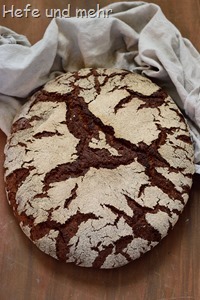 I like to bake “by order” as I can then bake bread I bake rather seldom. Pure Rye bread, for example, as I have a rather sensitive stomach who do not like the higher acidity of rye bread. And while I do not eat rye bread I still like to bake it. Its different consistency makes it a bit challenging and is a nice change in my wheat- and spelt-dough routine.
I like to bake “by order” as I can then bake bread I bake rather seldom. Pure Rye bread, for example, as I have a rather sensitive stomach who do not like the higher acidity of rye bread. And while I do not eat rye bread I still like to bake it. Its different consistency makes it a bit challenging and is a nice change in my wheat- and spelt-dough routine.
For this bread which I bake for a big birthday I choose so called “Lichtkornroggen”. This is a rye variety containing light coloured rye seeds instead of the normal grey green coloured rye. It is a modern back breeding from ancient rye varieties and yields a lighter bread then normal whole rye flour. Its flavour is milder as well and so I build the sourdough in the classical german “three stages”: The so called “Anfrischsauer” (refreshed sourdough) to activate the yeasts is then followed by the low hydrated “Grundsauer” (basic sourdough) to generate a well balanced acidity and the last step called “Vollsauer” (complete sourdough) in which the warm and soft dough is perfect for yeast and homofermenting lactobacteria and in which the sourdough develops a lot of activity. Continue reading
Onion Bread
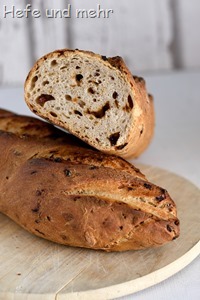 Reader’s wishes are a good thing. They often give me new impulses or remind me of – sometime to obvious – breads. And when Julia wrote that a recipe for onion bread would be a fine idea, I was thinking: of course! And for the past long, sunny weekend I started to create a recipe.
Reader’s wishes are a good thing. They often give me new impulses or remind me of – sometime to obvious – breads. And when Julia wrote that a recipe for onion bread would be a fine idea, I was thinking: of course! And for the past long, sunny weekend I started to create a recipe.
A crucial part of onion bread is fried onions. And as I do not like the store bought ones very much I decided to go for homemade fried onions, too. For a better contrast I chose red onions for that. They are fried in oil until all of their water evaporates and are very crips. About 300g fresh onions yields 100g fried ones.
For the form I chose two different ones: the “classical” onion batard and round loaves with a half onion in the middle. These breads are a nice eye catcher for a buffet, but the batards are easier to cut.

